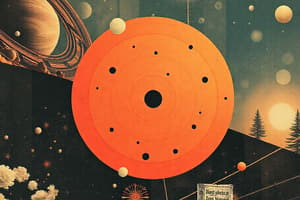Podcast
Questions and Answers
Which factor determines the direction of the force between magnets?
Which factor determines the direction of the force between magnets?
- Mass of the magnets
- Magnetic properties of the material
- Orientation of the magnets (correct)
- Distance between the magnets
What property of a material affects the strength of its magnetic field?
What property of a material affects the strength of its magnetic field?
- Orientation of the material
- Density of the material
- Distance between the magnetic fields
- Magnetic properties of the material (correct)
In what aspect are gravitational and magnetic fields similar?
In what aspect are gravitational and magnetic fields similar?
- Both have constant field strength
- Both attract objects at a distance (correct)
- Both can only attract objects
- Both depend on mass
What determines the amount of force exerted by a gravitational field?
What determines the amount of force exerted by a gravitational field?
How does energy in a gravitational field depend on mass and position?
How does energy in a gravitational field depend on mass and position?
Which factor does NOT affect the strength of a magnetic field?
Which factor does NOT affect the strength of a magnetic field?
What is a key difference between gravitational and magnetic fields?
What is a key difference between gravitational and magnetic fields?
What is potential energy in a field due to?
What is potential energy in a field due to?
Flashcards are hidden until you start studying
Study Notes
Gravitational and Magnetic Fields
- Forces caused by gravitational and magnetic fields are observable in daily life.
- Engineers use knowledge of fields to generate forces in designs, such as roller coasters and headphones.
Force and Fields
- A force is a push or a pull on an object, which can cause it to change its motion.
- Forces happen in pairs when two objects interact with each other.
- Forces can occur over great distances, such as the gravitational force between the Moon and the Earth.
- Fields, including gravitational and magnetic fields, can exert a force at a distance.
Gravitational Fields
- A gravitational field exists in and around every object with mass.
- The strength of a gravitational field depends on the mass of the object.
- A gravitational field generates a force only when a second object is placed in the field.
- The gravitational force between two objects is always attractive, never repulsive.
- The force depends on the distance between the objects and the mass of each object.
Magnets and their Fields
- Every magnet has two poles, north and south, and it is impossible to have a magnet with only one pole.
- Magnets can either attract or repel other magnetic objects, depending on the orientation of their poles.
- Similar poles repel, and opposite poles attract.
- A magnetic field around an object is the result of the object's material properties.
- A material is magnetized when domains inside the material are aligned.
- Permanent magnets have aligned domains, while temporary magnets have domains that can be aligned by a magnetic field.
Comparing Fields
- Gravitational and magnetic fields both exert a force at a distance on an object.
- The amount of force exerted by the field depends on the location of the object in the field.
- Both fields can be mapped by their effects on certain objects.
- Key differences between gravitational and magnetic fields include:
- Gravitational field strength depends on mass.
- Magnetic field strength depends on the magnetic properties of the material.
- Gravitational fields always attract, while magnetic fields can attract or repel.
Energy in a Field
- An object in a field has potential energy due to its position in that field.
- The gravitational potential energy of an object in a gravitational field depends on its mass and position.
Studying That Suits You
Use AI to generate personalized quizzes and flashcards to suit your learning preferences.




